Physical Address
304 North Cardinal St.
Dorchester Center, MA 02124
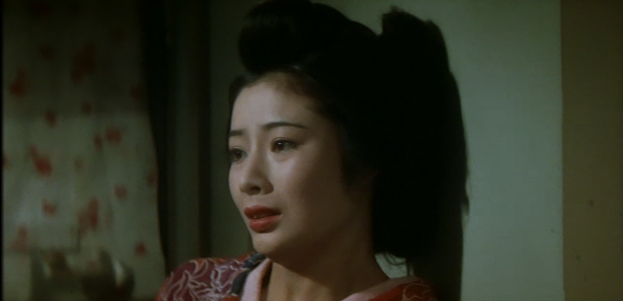
(Continued from page 2)
In addition to being a crime story and a love story, this film is also very much a tale of male bonding, though the most important male relationship in the narrative is not that between Kaku and his fellow gang member, Miyagawa, but between Kaku and the “elder statesman” yakuza, Kiratsune. It’s very interesting that, whereas the Sawashima film begins with Kaku in his prison cell, and then flashes back to the beginning of the events of the main plot, the Uchida film begins with Kiratsune visiting the grave of his oyabun, the patriarch Hyōtarō, which has nothing at all to do with that plot. (In Uchida’s film, Kaku, the protagonist, does not even appear until about seventeen minutes after the opening credits.) According to screenwriter Suzuki Naosuke (as noted in the article on this film in Japanese Wikipedia), Uchida identified with Kiratsune, rather than with the characters of the younger yakuza Hishakaku and Miyagawa. This may explain the older character’s extraordinary prominence in the narrative, as well as the inclusion of his name in the film’s Japanese title.
In the 1936 film, Theater of Life: Youth Version, Kiratsune is dramatically involved in the Aonari’s family’s fate from the beginning, but in this film, he’s more like a one-man Greek chorus, seemingly detached, because of his age and status, from the emotions that drive Kaku, Miyagawa and Hyōkichi. Kiratsune apparently has no family and no “significant other.” Therefore, like Umeda in Twilight Saloon (1955) or Chikamatsu in Chikamatsu’s Love in Osaka, his remoteness from the passions that motivate the others makes him the ideal observer (and Good Samaritan) in the world of the film.
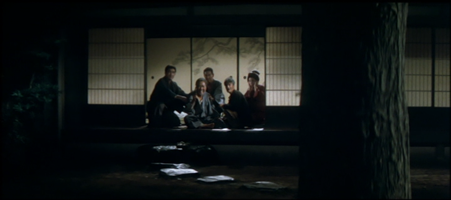
He is clearly intended to represent a surrogate father figure for both Kaku and Hyōkichi. In a flashback, he is shown observing the ritual – also dramatized in Uchida’s 1936 film – in which the yakuza patriarch Hyōtarō, in the presence of his young son, Hyōkichi, brandishes a pistol near the tall, ancient tree on the father’s property (though in the earlier film, he doesn’t actually fire it). This macho ritual clearly signifies a rite of passage for father and son, and it turns into just such a rite for Kiratsune as well, since he fires the same pistol at the very same tree just before he dies, as if he had become Hyōtarō.
Uchida, among his Japanese filmmaking peers, may have been second only to Kurosawa in the degree to which his characters seem to require some sort of father figure to guide them. Indeed, in A Bloody Spear at Mt. Fuji (1955), there are two father figures: Tōzaburō, the poor man who uses the money he’d earned working in a mine to cancel the contract of a younger woman resembling his deceased daughter, who’s about to be sold into prostitution, and the government officer Denji, who shows up in the nick of time to set things right and assert an authority the other characters lack. In The Horse Boy, the father figure is the boy hero’s literal father, though the child, who thinks he’s an orphan, is at first unaware of the paternal connection.
In Chikamatsu’s Love in Osaka, Chubei, the hapless young clerk, is not nearly so fortunate. When he turns to his well-to-do biological father – to whom he is now, technically, unrelated, since the young man had allowed himself to be legally adopted as the “son” of a rich merchant family – to help him out of his financial crisis, the old man coldly responds with a letter filled with trite platitudes, in effect washing his hands of him. In this respect, Kaku is luckier, because he has his wise yakuza “father,” Kiratsune, to ease the pain of Otoyo’s infidelity and to help him forgive Miyagawa. And though this relationship is much the same as in the 1963 film, it is much more strongly stressed in Uchida’s movie.
The conclusion of the film has inspired far more comment than any other aspect of the work. This isn’t surprising, because that sequence “rhymes” with similar climactic scenes in slightly better-known Uchida movies, such as A Bloody Spear at Mt. Fuji and Hero of the Red-Light District. But the big difference between those two earlier works and this one is effectiveness. The dramatic climax of Hero, for example, is, in my view, one of the most cathartic in all Japanese Cinema… I am tempted to write “in all cinema.” However, in both that film and Bloody Spear, the protagonist (played in both cases by the wonderful Kataoka Chiezō) is a nonviolent, even mild-mannered man by temperament, and thus the shocking quality of those endings lies not just in the suddenness of the violence, but in the extreme bloodshed depicted.
The hero of A Tale of Two Yakuza, on the other hand, being a gang member, is violent on principle and as a way of life, and so the audience would be shocked if the film did not end in a bloodbath. Uchida was thus hamstrung not only by the fact that he was remaking a previously-produced work, but by the conventions of the genre in which he was working. The director’s challenge was therefore to find a way to make a thoroughly predictable ending interesting.
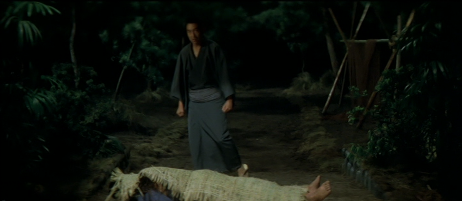
The ingenious but not quite satisfying solution that the director came up with was to shift to a completely different visual grammar for the film’s last few minutes, by changing the film stock from color to black-and-white and using a handheld rather than a stable camera to record the final showdown between Kaku and his adversaries. However, Uchida doesn’t alter the aspect ratio of the image, so the visual look of this scene recalls his previous widescreen black-and-white films, The Eleventh Hour (1957) and A Fugitive from the Past.
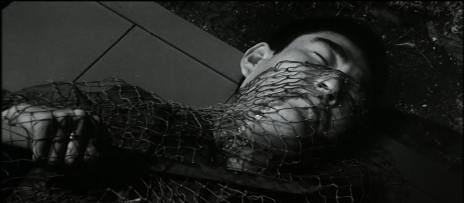
The scene begins at night with Kaku walking towards the gang’s hideout to avenge Miyagawa’s killing. Even the sudden appearance of Otoyo can’t dissuade him, and he roughly casts her aside. He comes upon a corpse lying on the ground, covered in a bamboo “blanket.” Kaku pulls away this covering. The film turns to black-and-white as the viewer sees, roughly from Kaku’s point-of-view, the dead Miyagawa, his face half-obscured by the rope netting in which he had become ensnared prior to being stabbed to death. The image isn’t particularly shocking, even by the standards of that era, but it carries considerable dramatic weight because of the depth and complexity of the relationship between the men, involving as it does transgression, guilt and atonement.
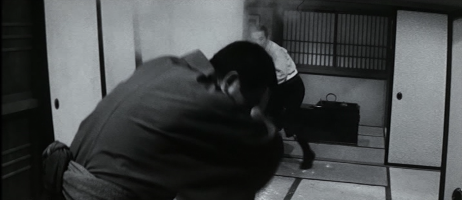
The gang then emerges from its hideout, challenging Kaku. He suddenly lunges at one of them, stabbing him. The battle that ensues is well-choreographed… too much so, because it so obviously has been choreographed. The chaotic activity, which includes such unsporting behavior as flinging dirt in an opponent’s eyes, nevertheless feels a bit stiff and not quite convincing, despite the aggressive jiggling of the camera to create a dynamic feel. As I’ve written elsewhere, what I call “one-man army” scenes in Japanese swordfight films – the thrilling climax of Hero of the Red-Light District is a spectacular exception – almost always put me off. And Tsuruta Kōji, as good an actor as he is, can’t quite convincingly convey crazed fury, as the older Kataoka wonderfully managed to do in the earlier films.
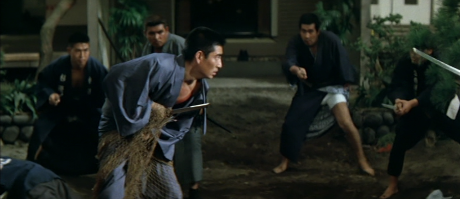
A much better fight scene occurs just a few minutes earlier in the movie, when Miyagawa – on a suicide mission to atone for his guilt vis-à-vis Kaku – storms the rival gang’s hideout. Masterfully, Uchida allows us to hear the attack without seeing it, as the camera is on the outside of the house, with the walls blocking our view… until Miyagawa suddenly crashes through one of those walls into the front yard, pursued by several armed yakuza. The fight ends as it would probably have in life, with Miyagawa managing to take out a few of the enemy’s men until the rest of the gang surround and slaughter him. Paradoxically, the sheer hopelessness of his battle makes Miyagawa seem a much great hero than Kaku, though the latter survives.
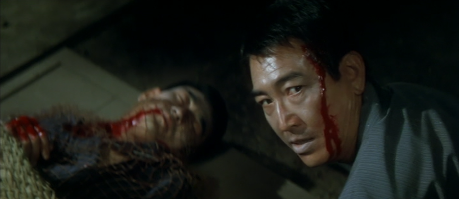
Kaku, after dispatching the gang, returns to Miyagawa’s corpse to mourn the waste of his (and perhaps his own) life. Otoyo then reenters the scene, and it’s as if she has brought pigment with her, because, with her arrival, color returns to the image. We then see a closeup of Kaku’s face, but the redness of the “blood” on it looks too much like stage blood, which may in fact have been Uchida’s intent, but is distracting to the viewer.
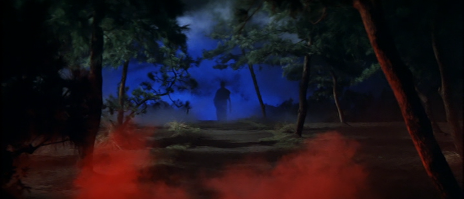
As he walks off alone toward the horizon, a mystical blue light appears in the sky and a bright red mist slowly rises from the ground. I’m at a loss to figure out what this imagery is supposed to signify. The strange thing is, the final shot of Hero of the Red-Light District, with that storm of cherry blossoms falling, impossibly, on the hero and his enemies from above the cherry trees, somehow makes perfect sense to me, but the blue light and red mist in this ending make no sense to me at all. Perhaps Uchida wants to present Kaku as an icon, some kind of yakuza saint, but nothing the character has done would seem to justify this. It’s the kind of off-the-wall ending that I, as a young movie fan, might have once thought cool, but which now leaves me somewhat cold.
On the other hand, it’s intriguing that, in this one scene, all three of Uchida’s characteristic styles are combined: the classical (the initial section in color), the realist (the fight scene in black-and-white, with a handheld camera) and the mannerist (that final shot). As far as I can recall, this is the only time this occurs in all Uchida’s cinema.
Though a minor movie, Uchida’s penultimate work is an elegant and intelligent addition to the 1960s yakuza genre, and definitely doesn’t deserve to be ignored or dismissed.
Wild Realm Reviews (Paghat the Ratgirl) – Paghat discusses both Uchida’s 1936 and 1968 adaptations of Ozaki Shirō’s work. Of the latter, she writes, “The formidable significance of Tomu Uchida as director, as well as his fantastic cast, renders Uchida’s version the default standard… It’s a wonderful film & deserves to be famous, but the same could be said of other versions of the same story.”
JAPANONFILM [Blogger] – Theater of Life: Hishakaku (Jinsei gekijō – Hishakaku) – A review of the 1963 Sawashima Tadashi version of Ozaki’s narrative, also released by Toei, which is close in plot to, but quite different in tone and style from, Uchida’s version.
MOMA 2016 Uchida Retrospective – Plot summary of the film
Tokyo FILMeX – Description of film as entry in a 2004 Uchida Retrospective
Japan Foundation (Japanisches Kulturinstitut – Germany) – Events Calendar item for a 2006 screening of the film, with plot summary, translated into English